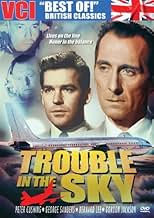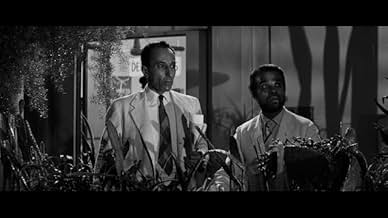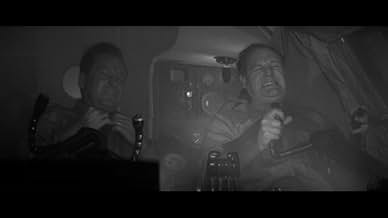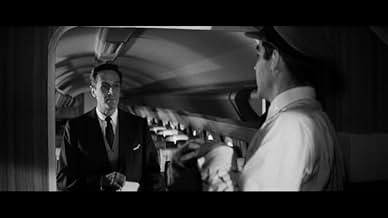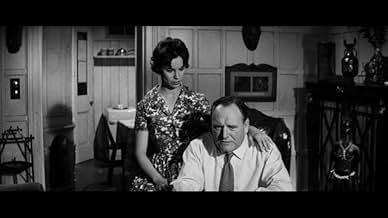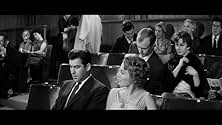VALUTAZIONE IMDb
6,5/10
472
LA TUA VALUTAZIONE
Aggiungi una trama nella tua linguaIn Britain, at the dawn of jet-powered commercial aviation, an aircraft manufacturer tries to shift the blame from mechanical failure to pilot error when its newest jet airliner has a series... Leggi tuttoIn Britain, at the dawn of jet-powered commercial aviation, an aircraft manufacturer tries to shift the blame from mechanical failure to pilot error when its newest jet airliner has a series of accidents.In Britain, at the dawn of jet-powered commercial aviation, an aircraft manufacturer tries to shift the blame from mechanical failure to pilot error when its newest jet airliner has a series of accidents.
- Regia
- Sceneggiatura
- Star
André Morell
- Capt. Manningham
- (as Andre Morell)
Charles 'Bud' Tingwell
- Capt. Braddock
- (as Charles Tingwell)
Recensioni in evidenza
1960's "Trouble in the Sky" (British title "Cone of Silence") is an excellent airplane drama featuring as fine a cast as could be found in British films that year. At the center of it all is future 'M' in the James Bond series, Bernard Lee as Captain George Gort, who is found guilty of pilot error after a recent crash of the new Phoenix resulted in the death of his co-pilot. Captain Edward Manningham (Andre Morell) leaves Gort's fate in the judgment of examiner Hugh Dallas (Michael Craig), whose subsequent test is passed with flying colors, enabling Gort to continue his career, having logged more miles in the air than all the other pilots combined. One such pilot is Captain Clive Judd (Peter Cushing), who believes in Gort's guilt, conspiring to undermine him and have him reassigned to a ground position. Gort's rock solid convictions are so trustworthy that we too believe him to be innocent of any negligence, so it's quite a shock when similar circumstances result in an identical crash, this time killing the dedicated pilot. By now, Dallas too is convinced that the fault lies elsewhere, with the comeuppance of the arrogant Judd a key factor in finding the truth. Based on the actual 1953 case of the DeHavilland Comet, Britain's first passenger jet airliner, the remainder of the cast comes off like a Who's Who of vintage 60s cinema: Gordon Jackson, Charles Tingwell, Noel Willman, Marne Maitland, Jack Hedley, Charles Lloyd Pack, Anthony Newlands, Gerald Sim, and Geoffrey Bayldon. Of special mention is the supporting presence of George Sanders, coming off the heroic "Village of the Damned" and the villainous "Bluebeards Ten Honeymoons," here in more typical form as smarmy attorney Sir Arnold Hobbes, his damning courtroom highjinks convicting the innocent Gort. As for second-billed Peter Cushing, he makes just one appearance before the film's second half, beginning a string of nine consecutive non genre features in a failed effort to avoid the horror typecasting that Christopher Lee also feared.
This is quite a good movie with a cast of familiar faces (Peter Cushing, George Sanders, Gordon Jackson). The screenplay is based on David Beaty's novel which was inspired by actual events. In October 1952 one of BOAC's new Comet jetliners crashed at Rome Airport. The accident was due to a design error that allowed the pilot to raise the nose too high on take off and stall the airplane on the ground. The pilot was blamed for the crash and relegated to flying piston engined freighters. The following year another Comet, on a delivery flight to Canadian Pacific Airlines crashed on taking off from Karachi, Pakistan in identical circumstances. Following this accident, design modifications were made to the Comet to prevent further similar incidents.
The movie follows this scenario quite closely, except that Captain Gort, the pilot blamed for the crash (played by Bernard Lee), continues to fly the fictional "Phoenix" jets and subsequently dies in an identical accident. It is left to the Airline's initially sceptical training Captain (Michael Craig) and Captain Gort's daughter (Elizabeth Seal) to clear her father's name and get the airplane modified in the nick of time to prevent a third crash.
Although made on a smallish budget and with some model shots that look a little shaky today, this is a cut above the typical Hollywood airborne disaster epic. Little seen today, especially in it's original 'scope ratio, this deserves more recognition.
The movie follows this scenario quite closely, except that Captain Gort, the pilot blamed for the crash (played by Bernard Lee), continues to fly the fictional "Phoenix" jets and subsequently dies in an identical accident. It is left to the Airline's initially sceptical training Captain (Michael Craig) and Captain Gort's daughter (Elizabeth Seal) to clear her father's name and get the airplane modified in the nick of time to prevent a third crash.
Although made on a smallish budget and with some model shots that look a little shaky today, this is a cut above the typical Hollywood airborne disaster epic. Little seen today, especially in it's original 'scope ratio, this deserves more recognition.
Airline pilot Bernard Lee is downgraded for 'pilot error', and eventually reinstated at full rating. His daughter, Elizabeth Seal, knows him for a by-the-book sort of man and puts a bug in the ear of pilot tester Michael Craig. He begins to suspect that the problem lies not in the pilot, but in the new jet plane; the company that manufactures it prefers to blame the man, rather than lose out in a hotly contested, lucrative market.
The movie is suggested by some issues in the De Havilland comet, the first commercial jet liner, in the early 1950s. Jet aviation was a hot topic for the movies, and NO HIGHWAYS IN THE SKY was on the film makers' minds as a likely model. All of the pilots start out being by-the-book, but their individual characters, both as men and pilots, come gradually to the fore, with Gordon Jackson (whose character is called, ineviltably, 'Jock') speaking offhandedly of instinct. In the meantime, we are confronted by everyone except Craif and Miss Seal, being walking avatars of professional probity, from George Sanders, who asks the correct questions at hearings, to Peter Cushing , who demands a retest of Lee .... and who is shocked to learn that he may have been guilty of a near-accident .... missed, like many, it is suggested, by sheer luck.
It's interesting to see in the cast so many actors who spent their careers playing villains. Instead they are tightly repressed. It's an interesting, coolly intellectualized movie that pits man and experience against the sleek, mechanized world we were moving into in the 1950s. The only strike against it is its lack of overt excitement around a now outmoded tecnology. Perhaps the modern audience would find it as relevant as a movie about steam automobiles that keep exploding. On the other hand, recent news about the Boeing 737 may make it telling.
The movie is suggested by some issues in the De Havilland comet, the first commercial jet liner, in the early 1950s. Jet aviation was a hot topic for the movies, and NO HIGHWAYS IN THE SKY was on the film makers' minds as a likely model. All of the pilots start out being by-the-book, but their individual characters, both as men and pilots, come gradually to the fore, with Gordon Jackson (whose character is called, ineviltably, 'Jock') speaking offhandedly of instinct. In the meantime, we are confronted by everyone except Craif and Miss Seal, being walking avatars of professional probity, from George Sanders, who asks the correct questions at hearings, to Peter Cushing , who demands a retest of Lee .... and who is shocked to learn that he may have been guilty of a near-accident .... missed, like many, it is suggested, by sheer luck.
It's interesting to see in the cast so many actors who spent their careers playing villains. Instead they are tightly repressed. It's an interesting, coolly intellectualized movie that pits man and experience against the sleek, mechanized world we were moving into in the 1950s. The only strike against it is its lack of overt excitement around a now outmoded tecnology. Perhaps the modern audience would find it as relevant as a movie about steam automobiles that keep exploding. On the other hand, recent news about the Boeing 737 may make it telling.
I haven't seen this film for years, which is a pity because all i remember are a few powerful scenes thanks to the very impressive cast. Based on true events, but subtly changed to avoid law-suits, its actually a compelling little drama, a shame it hasn't been shown more often. The story on which it is based, the KNOWN Design Flaws in the Comet which were Covered up by the De Havilland company, and the subsequent "sacrifice" of an entire airline and its passengers in Italy, is actually screaming out to be remade! In this case, the truth is far worse than fiction...in the film, decent noble people save the day, in the reality alas...less noble and darker motives won...and people died needlessly. The performances in this little melodrama were so good, i actually remembered this film for at least 25 years...thats when i last saw it i think..well worth catching.
In the set CUSHING CURIOSITIES, there are 5 feature films and the 6 remaining episodes of the BBC's SHERLOCK HOLMES series from 1968. The movies were made between 1959 and 1974 and reflect not only the growth of Cushing's career but the many changes in society and the movie industry that brought about the end of the Gothic horror films in which he specialized. Three of the films are in black and white. SUSPECT (1960) and THE MAN WHO FINALLY DIED (1962) have pre-James Bond espionage themes. CONE OF SILENCE, based on a book, deals with faulty aircraft design and is based on fact.
In SUSPECT, Cushing plays a scientist who wishes to publish his findings on deadly bacteria while the British Government wants them withheld from public knowledge. The film co-stars Donald Pleasance and Ian Bannen. In THE MAN WHO FINALLY DIED, Cushing is an ex-Nazi who is trying to commit insurance fraud...or is he? Headlining the movie is Stanley Baker, just 2 years away from international stardom in ZULU. Baker plays a man who is shocked to discover that his German father (not Cushing), whom he thought was long dead, is still alive. Both movies are tense and terse.
The earliest movie in the set, CONE OF SILENCE, dates from 1959. It tells the story of a new line of airplanes that sometimes crash while attempting to land. Peter is an ambitious pilot who, in order to advance his career, blames the crashes on an older cohort rather than the structural flaw he knows to be the real cause. The film has a strong cast that includes George Sanders and Bernard Lee. Future Hammer regulars Andre Morell and Marne Maitland have significant supporting roles. As stated earlier, the screenplay is based on fact.
The other two films, BLOODSUCKERS and TENDER DRACULA are both in color, made in the early 1970s and were barely released. The first movie, about modern day vampires, suffered from producer interference resulting in the director having his name removed. It also underwent several name changes. I first saw it in a drive-in and it wasn't half bad. In addition to Cushing, it has the added presence of Patrick Macnee and Edward Woodward. The 10 minute LSD induced orgy scene, which caused the director to leave and was ultimately cut, has been restored here. .. SPOILER ALERT!... It adds absolutely nothing to the film.
TENDER DRACULA is a real oddity. It was made in France in 1974 and, aside from Cushing and THE THIRD MAN star Alida Valli, features an all French cast and crew. It was intended to be a combination horror comedy and sex farce and how well it succeeds will depend on your taste for...French horror comedies / sex farces. It does have its admirers but only in France which is the only place it was released before going straight to video. Whether it is Cushing's worst movie is debatable. He didn't think so, giving that distinction to 1967's THE BLOOD BEAST TERROR, but TD gets my vote.
As for the 6 SHERLOCK HOLMES episodes, they prove that Peter Cushing was one of the great Holmes interpreters right up there with Jeremy Brett and Basil Rathbone. His lean, gaunt features, dismissive attitude, and nervous energy are very close to Doyle's description of the character. Cushing also insisted that his wardrobe match the illustrations from the Victorian period magazines where Holmes first appeared. Nigel Stock is the perfect Dr. Watson. An ordinary man who helps to ground his extraordinary friend. Of the stories, only A STUDY IN SCARLET disappoints as the murderer's background has been eliminated.
So, in the final summary, CUSHING CURIOSITIES is a must for all fans of the actor even if not all the material is first rate. It gives us a chance to see Peter in some of his solid supporting roles before he became a horror star and some lesser known movies that he made to keep himself busy after his wife died in 1971... For more reviews visit The Capsule Critic.
In SUSPECT, Cushing plays a scientist who wishes to publish his findings on deadly bacteria while the British Government wants them withheld from public knowledge. The film co-stars Donald Pleasance and Ian Bannen. In THE MAN WHO FINALLY DIED, Cushing is an ex-Nazi who is trying to commit insurance fraud...or is he? Headlining the movie is Stanley Baker, just 2 years away from international stardom in ZULU. Baker plays a man who is shocked to discover that his German father (not Cushing), whom he thought was long dead, is still alive. Both movies are tense and terse.
The earliest movie in the set, CONE OF SILENCE, dates from 1959. It tells the story of a new line of airplanes that sometimes crash while attempting to land. Peter is an ambitious pilot who, in order to advance his career, blames the crashes on an older cohort rather than the structural flaw he knows to be the real cause. The film has a strong cast that includes George Sanders and Bernard Lee. Future Hammer regulars Andre Morell and Marne Maitland have significant supporting roles. As stated earlier, the screenplay is based on fact.
The other two films, BLOODSUCKERS and TENDER DRACULA are both in color, made in the early 1970s and were barely released. The first movie, about modern day vampires, suffered from producer interference resulting in the director having his name removed. It also underwent several name changes. I first saw it in a drive-in and it wasn't half bad. In addition to Cushing, it has the added presence of Patrick Macnee and Edward Woodward. The 10 minute LSD induced orgy scene, which caused the director to leave and was ultimately cut, has been restored here. .. SPOILER ALERT!... It adds absolutely nothing to the film.
TENDER DRACULA is a real oddity. It was made in France in 1974 and, aside from Cushing and THE THIRD MAN star Alida Valli, features an all French cast and crew. It was intended to be a combination horror comedy and sex farce and how well it succeeds will depend on your taste for...French horror comedies / sex farces. It does have its admirers but only in France which is the only place it was released before going straight to video. Whether it is Cushing's worst movie is debatable. He didn't think so, giving that distinction to 1967's THE BLOOD BEAST TERROR, but TD gets my vote.
As for the 6 SHERLOCK HOLMES episodes, they prove that Peter Cushing was one of the great Holmes interpreters right up there with Jeremy Brett and Basil Rathbone. His lean, gaunt features, dismissive attitude, and nervous energy are very close to Doyle's description of the character. Cushing also insisted that his wardrobe match the illustrations from the Victorian period magazines where Holmes first appeared. Nigel Stock is the perfect Dr. Watson. An ordinary man who helps to ground his extraordinary friend. Of the stories, only A STUDY IN SCARLET disappoints as the murderer's background has been eliminated.
So, in the final summary, CUSHING CURIOSITIES is a must for all fans of the actor even if not all the material is first rate. It gives us a chance to see Peter in some of his solid supporting roles before he became a horror star and some lesser known movies that he made to keep himself busy after his wife died in 1971... For more reviews visit The Capsule Critic.
Lo sapevi?
- QuizThe aircraft featured in the film is an Avro Ashton 3. It was built as a research aircraft and at the time of filming was being employed by Bristol Siddeley Engines (now Rolls Royce) in engine testing.
- ConnessioniReferenced in Michael Craig (2022)
I più visti
Accedi per valutare e creare un elenco di titoli salvati per ottenere consigli personalizzati
- How long is Trouble in the Sky?Powered by Alexa
Dettagli
- Data di uscita
- Paese di origine
- Lingua
- Celebre anche come
- Trouble in the Sky
- Luoghi delle riprese
- Shepperton Studios, Studios Road, Shepperton, Surrey, Inghilterra, Regno Unito(studio: made at Shepperton Studios Middlesex, England.)
- Azienda produttrice
- Vedi altri crediti dell’azienda su IMDbPro
- Tempo di esecuzione1 ora 32 minuti
- Colore
Contribuisci a questa pagina
Suggerisci una modifica o aggiungi i contenuti mancanti

Divario superiore
By what name was La tragedia del Phoenix (1960) officially released in India in English?
Rispondi
